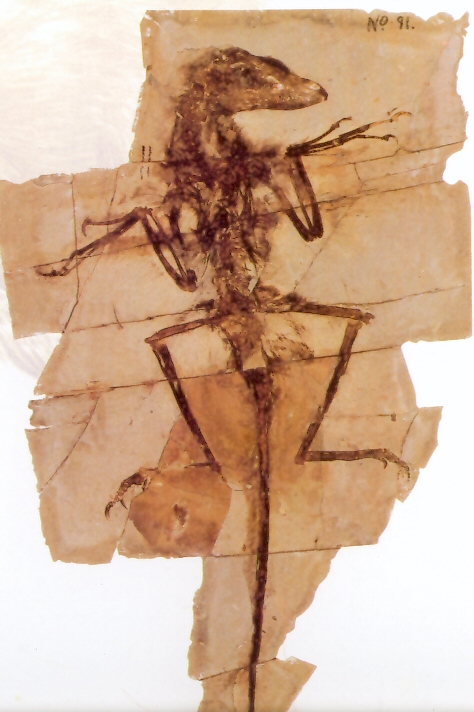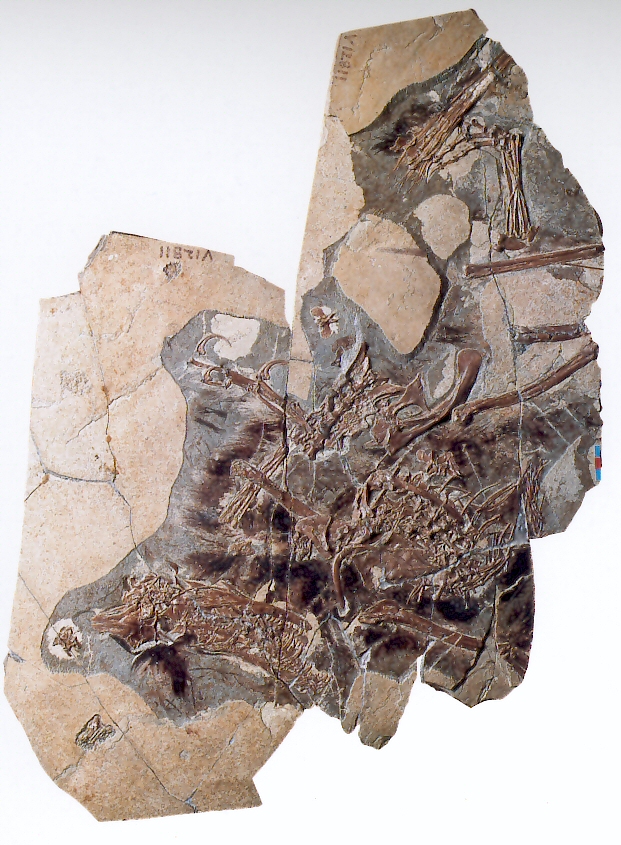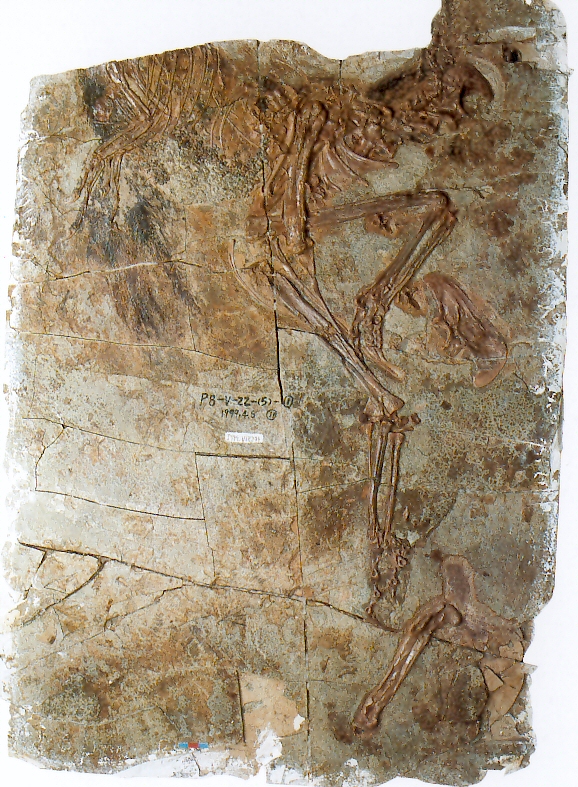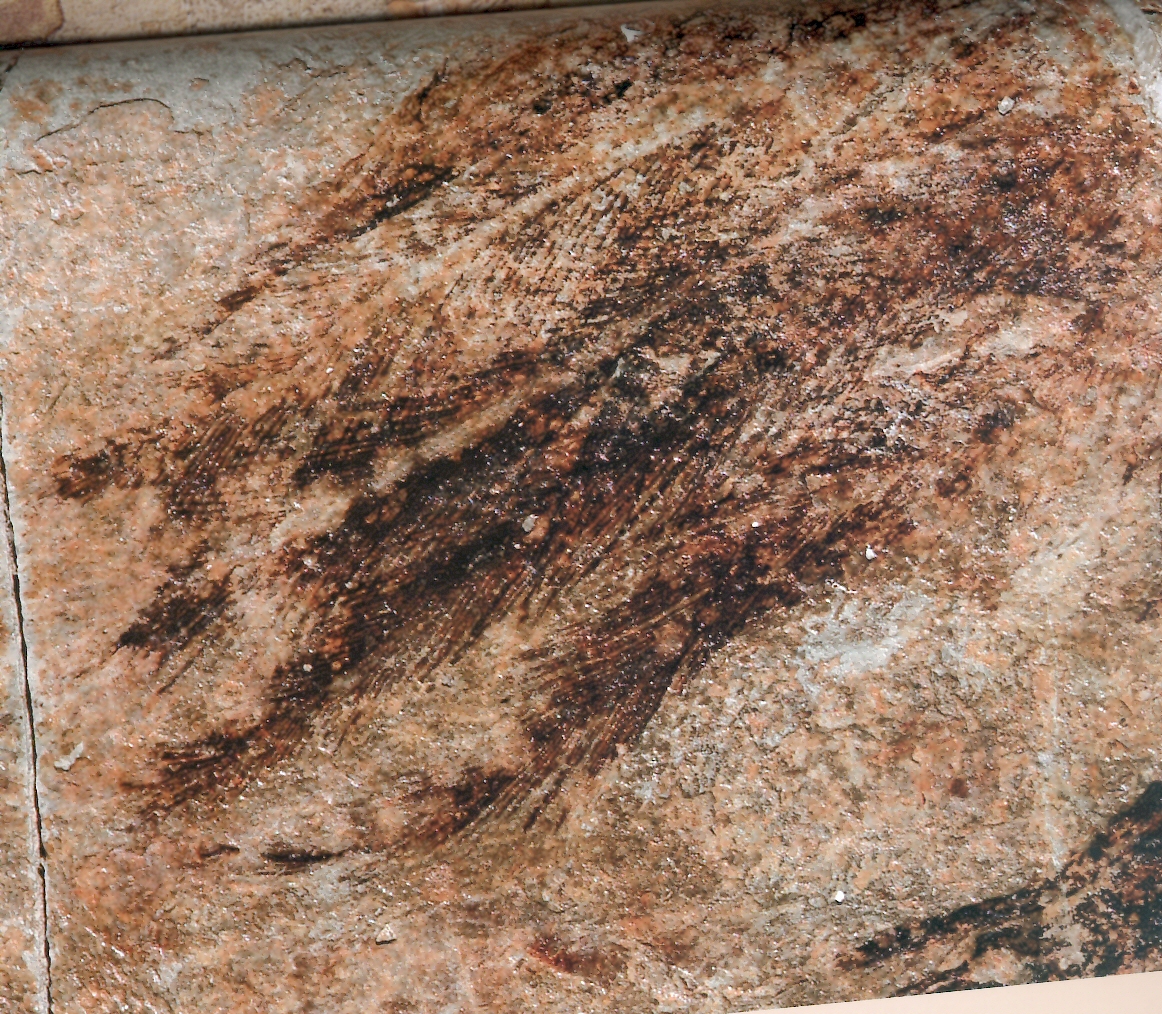http://www.sciencedaily.com/releases/2005/10/051010085411.htm
CHAPEL HILL -- No good evidence exists that fossilized structures found in China and which some paleontologists claim are the earliest known rudimentary feathers were really feathers at all, a renowned ornithologist says. Instead, the fossilized patterns appear to be bits of decomposed skin and supporting tissues that just happen to resemble feathers to a modest degree.
Led by Dr. Alan Feduccia of the University of North Carolina at Chapel Hill, a team of scientists says that as a result of their new research and other studies, continuing, exaggerated controversies over "feathered dinosaurs" make no sense.
"We all agree that birds and dinosaurs had some reptilian ancestors in common," said Feduccia, professor of biology in UNCs College of Arts and Sciences. "But to say dinosaurs were the ancestors of the modern birds we see flying around outside today because we would like them to be is a big mistake.
"The theory that birds are the equivalent of living dinosaurs and that dinosaurs were feathered is so full of holes that the creationists have jumped all over it, using the evolutionary nonsense of dinosaurian science as evidence against the theory of evolution," he said. "To paraphrase one such individual, This isnt science . . . This is comic relief."
A report on the teams latest research appears in the Journal of Morphology published online Monday (Oct. 10). Other authors are Drs. Theagarten Lingham-Soliar of the University of KwaZulu-Natal in South Africa and Richard Hinchliffe of the University College of Wales.
Using powerful microscopes, the team examined the skin of modern reptiles, the effects of decomposition on skin and the fossil evidence relating to alleged feather progenitors, also known as "protofeathers."
They found that fossilized patterns that resemble feathers somewhat also occur in fossils known not to be closely related to birds and hence are far more likely to be skin-related tissues, Feduccia said. Much of the confusion arose from the fact that in China in the same area, two sets of fossils were found. Some of these had true feathers and were indeed birds known as "microraptors," while others did not and should not be considered birds at all.
"Collagen is a scleroprotein, the chief structural protein of the connective tissue layer of skin," he said. "Naturally, because of its low solubility in water and its organization as tough, inelastic fiber networks, we would expect it to be preserved occasionally from flayed skin during the fossilization process."
Although a few artists depicted feathered dinosaurs as far back as the 1970s, Feduccia said the strongest case for feathered dinosaurs arose in 1996 with a small black and white photo of the early Cretaceous period small dinosaur Sinosauropteryx, which sported a coat of filamentous structures some called "dino-fuzz."
"The photo subsequently appeared in various prominent publications as the long-sought definitive evidence of dinosaur feathers and that birds were descended from dinosaurs," he said. "Yet no one ever bothered to provide evidence -- either structural or biological -- that these structures had anything to do with feathers. In our new work, we show that these and other filamentous structures were not protofeathers, but rather the remains of collagenous fiber meshworks that reinforced the skin."
Belief in the existence of the "dino-fuzz feathers" caused some scientists to conclude that they served as insulation, and hence dinosaurs were warm-blooded.
The researchers also examined evidence from five independent, agreeing studies involving structural and genetic analyses related to the "tridactyl," or three-fingered, hand, which is composed of digits 1, 2 and 3 in dinosaurs, Feduccia said. That is the most critical characteristic linking birds to dinosaurs. They found that embryos of developing birds differed significantly in that bird wings arose from digits 2, 3 and 4, the equivalent of index, middle and ring fingers of humans. To change so radically during evolution would be highly unlikely.
"If birds descended from dinosaurs, we would expect the same 1, 2 and 3 pattern," he said.
Current dinosaurian dogma requires that all the intricate adaptations of birds wings and feathers for flight evolved in a flightless dinosaur and then somehow became useful for flight only much later, Feduccia said. That is "close to being non-Darwinian."
Also, the current feathered dinosaurs theory makes little sense time-wise either because it holds that all stages of feather evolution and bird ancestry occurred some 125 million years ago in the early Cretaceous fossils unearthed in China.
"Thats some 25 million years after the time of Archaeopteryx, which already was a bird in the modern sense," he said. Superficially bird-like dinosaurs occurred some 25 million to 80 million years after the earliest known bird, which is 150 million years old."
Feduccia said the publication and promotion of feathered dinosaurs by the popular press and by prestigious journals and magazines, including National Geographic, Nature and Science, have made it difficult for opposing views to get a proper hearing.
"With the advent of feathered dinosaurs, we are truly witnessing the beginnings of the meltdown of the field of paleontology," he said. "Just as the discovery a four-chambered heart in a dinosaur described in 2000 in an article in Science turned out to be an artifact, feathered dinosaurs too have become part of the fantasia of this field. Much of this is part of the delusional fantasy of the world of dinosaurs, the wishful hope that one can finally study dinosaurs at the backyard bird feeder.
"It is now clear that the origin of birds is a much more complicated question than has been previously thought," Feduccia said.
The UNC scientist is the author of more than 150 papers and six major books, including The Age of Birds, which Harvard University Press published in 1980 and The Origin and Evolution of Birds, published by Yale University Press in 1996.
Among other discoveries, Feduccia found by a careful examination that Archaeopteryx, the earliest known bird and one of the worlds most famous fossils, could fly. Previously, many scientists thought the animal to be an Earth-bound dinosaur.
He determined its flying ability by observing that the fossils feathers had leading edges significantly shorter than their trailing edges, which is characteristic of all modern flying birds. The edges of feather of birds incapable of flight, such as ostriches, are symmetrical.











 !
!